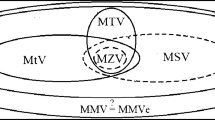Abstract
In this paper, we give an elementary account into Zagier’s formula for multiple zeta values involving Hoffman elements. Our approach allows us to obtain direct proof in a special case via rational zeta series involving the coefficient \(\zeta (2n)\). This formula plays an important role in proving Hoffman’s conjecture which asserts that every multiple zeta value of weight k can be expressed as a \(\mathbb {Q}\)-linear combinations of multiple zeta values of the same weight involving 2’s and 3’s. Also, using a similar hypergeometric argument via rational zeta series, we produce a new Zagier-type formula for the multiple special Hurwitz zeta values.
Similar content being viewed by others
References
Andrews, G.E., Askey, R., Roy, R.: Special Functions, Cambridge University Press, (2000)
Ayoub, R.: Euler and the zeta function. Am. Math. Monthly 81, 1067–1086 (1974)
Borwein, J.M., Bradley, D.M., Crandall, R.E.: Computational strategies for the Riemann zeta function. J. Comp. Appl. Math. 121, 247–296 (2000)
Borwein, J., Chamberland, M.: Integer powers of arcsin. Int. J. Math. Math. Sci. 2007 (2007), Article ID 19381, 10pp
Brown, F.: Mixed Tate motives over \({\mathbb{Z}}\). Ann. Math. (2) 175, 949–976 (2012)
Brown, F., Schnetz, O.: Single-valued multiple polylogarithms and a proof of the zig-zag conjecture. J. Number Theory 148, 478–506 (2015)
Burgos G., Fresan, J.: Multiple zeta values: from numbers to motives. Clay Math. Proc. (to appear)
Charlton, S.: \(\zeta (\{\{2\}^m, 1, \{2\}^m, 3\}^n, \{2\}^m)/\pi ^{4n+2m(2n+1)}\) is irrational. J. Number Theory 148, 463–477 (2015)
Chu, W., Zheng, D.: Infinite series with harmonic numbers and central binomial coefficients. Int. J. Number Theory 5, 429–448 (2009)
Chung, C.-L.: On the sum relation of multiple Hurwitz zeta functions. Quaest. Math. 42, 297–305 (2019)
Clausen, T.: Uber die function \(\sin \phi +\frac{1}{2^2}\sin 2\phi +\frac{1}{3^2}\sin 3\phi +\)etc. J. Reine Angew. Math. 8, 298–300 (1832)
Hoffman, M.E.: Multiple harmonic series. Pac. J. Math. 152, 275–290 (1992)
Hoffman, M.E.: The algebra of multiple harmonic series. J. Algebra 194, 477–495 (1997)
Hoffman, M.E.: An odd variant of multiple zeta values. Commun. Number Theory Phys. 13, 529–567 (2019)
Leshchiner, D.: Some new identities for \(\zeta (k)\). J. Number Theory 13, 355–362 (1981)
Li, Z.-H.: Another proof of Zagier’s evaluation formula of the multiple zeta values \(\zeta (2, \ldots , 2, 3, 2, \ldots , 2)\). Math. Res. Lett. 20, 947–950 (2013)
Lupu, C.: Analytic Aspects of the Riemann Zeta and multiple zeta values. PhD Thesis, available at http://d-scholarship.pitt.edu/35330/, University of Pittsburgh (2018)
Ram Murty, M., Sinha, K.: Multiple Hurwitz zeta functions. Proc. Sympos. Pure Math. 75, 135–156 (2006)
Orr, D.: Generalized rational zeta series for \(\zeta (2n)\) and \(\zeta (2n+1)\). Integral Transf. Spec. Funct. 28, 966–987 (2017)
Rainville, E.D.: Special Functions. Chelsea Publishing Co., New York (1971)
Shen, Z., Jia, L.: Some identities for multiple Hurwitz zeta values. J. Number Theory 179, 256–267 (2017)
Sun, Z.W.: New series for some special values of \(L\)-functions. Nanjiang Univ. J. Math. Biquarterly 32, 189–218 (2015)
Zagier, D.: Values of zeta functions and their applications, in Proceedings of the First European Congress of Mathematics, Vol. II (Paris, 1992), A. Joseph et. al. (eds.), Birkhäuser, Basel, 1994, pp. 497–512
Zagier, D.: Multiple zeta values, Unpublished manuscript, Bonn (1995)
Zagier, D.: Evaluation of the multiple zeta values \(\zeta (2, \ldots , 2, 3, 2, \ldots , 2)\). Ann. Math. (2) 175, 977–1000 (2012)
Zhao, J.: Sum formula of multiple Hurwitz-zeta values. Forum Math. 27, 929–936 (2015)
Zhao, J.: Multiple Zeta Functions, Multiple Polylogarithms, and their Special Values. World Scientific, Singapore (2016)
Acknowledgements
The author would like to thank Tom Hales, Bogdan Ion, Camil Muscalu, Derek Orr for fruitful conversations which preceded this work, and to Don Zagier for inspiring conversations on the subject. Also, many thanks to my advisors Piotr Hajlasz and William C. Troy for encouragements through my PhD studies. This paper is part of author’s PhD thesis at the University of Pittsburgh.
Author information
Authors and Affiliations
Additional information
Publisher's Note
Springer Nature remains neutral with regard to jurisdictional claims in published maps and institutional affiliations.
Appendix
Appendix
The Clausen function (integral) is defined by
and its Taylor series expansion is given by
The higher order Clausen functions are
Using the properties of the Riemann zeta function, we have the following particular values:
and
where \(\beta (s)=\sum _{n=0}^{\infty }\frac{(-1)^n}{(2n+1)^s}, {\text {Res}}>0\) is the Dirichlet beta function.
Moreover,
and
Proof of the Lemma 2.6
(see also [19]). Theorem 2.4 for \(z=\frac{1}{2}\) gives us
On the other hand, since \(\cot x=-2\sum \nolimits _{n=0}^{\infty }\frac{\zeta (2n)}{\pi ^{2n}}\cdot x^{2n-1}, |x|<\pi \), by integration and Fubini’s theorem, we obtain
or equivalently,
and the lemma follows immediately.\(\square \)
Rights and permissions
About this article
Cite this article
Lupu, C. Another look at Zagier’s formula for multiple zeta values involving Hoffman elements. Math. Z. 301, 3127–3140 (2022). https://doi.org/10.1007/s00209-022-02990-0
Received:
Accepted:
Published:
Issue Date:
DOI: https://doi.org/10.1007/s00209-022-02990-0
Keywords
- Multiple zeta values
- Zagier’s formula for Hoffman elements
- Riemann zeta function
- Clausen function
- Gauss hypergeometric function



